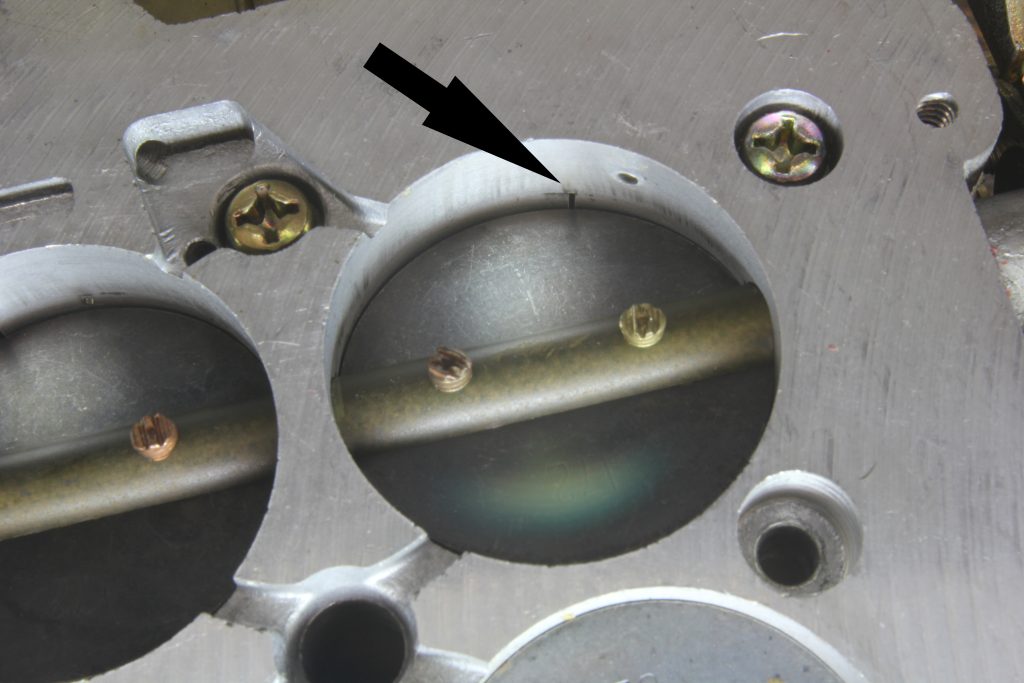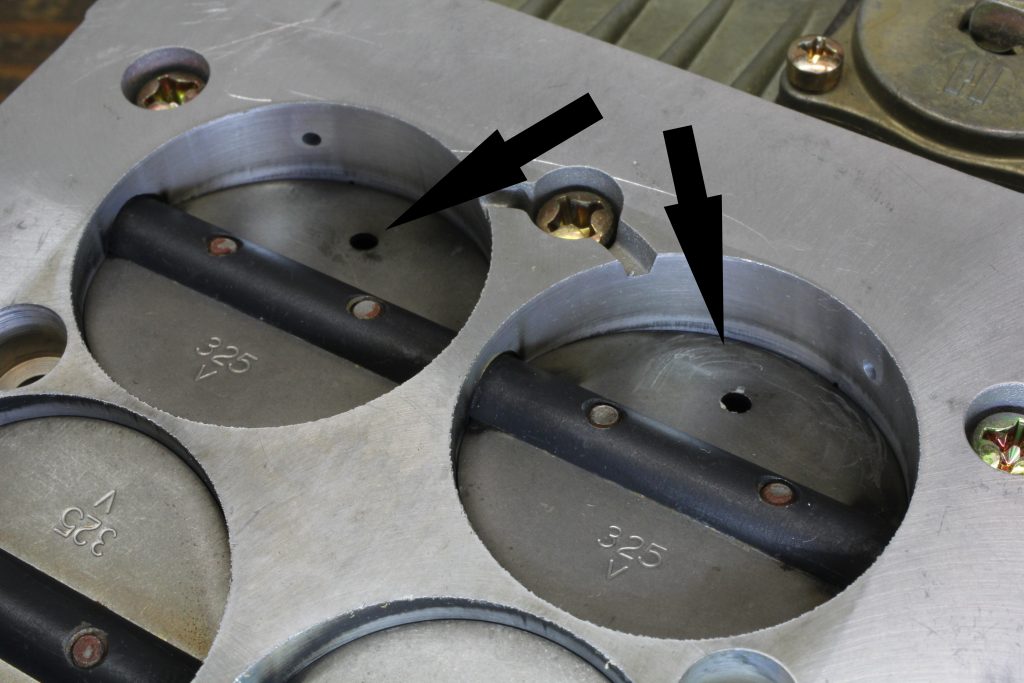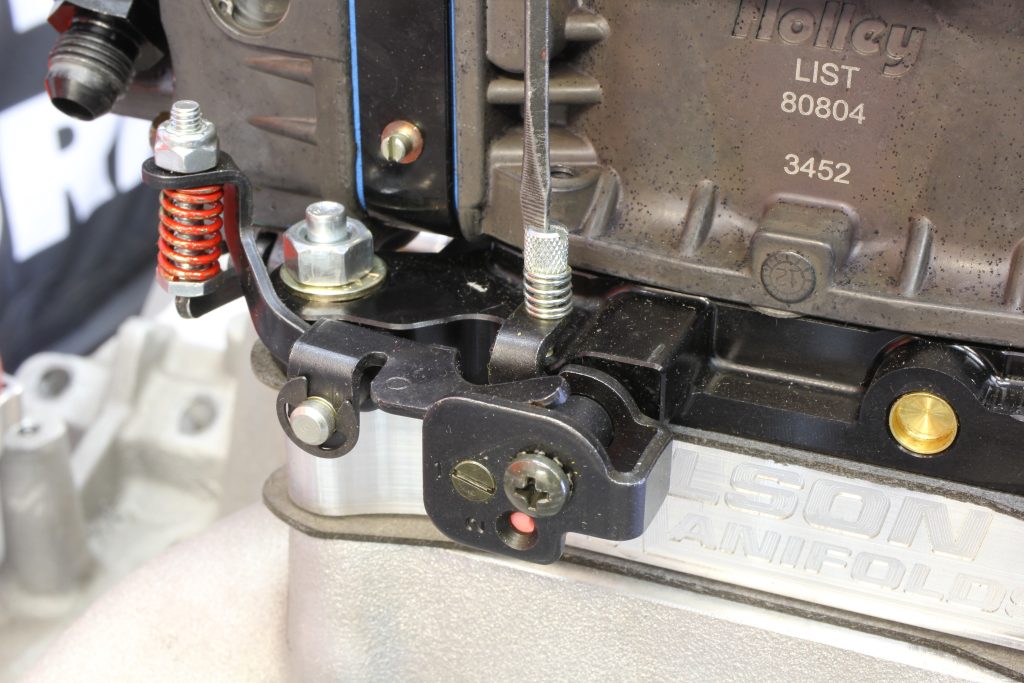Recently you wrote an article that mentioned drilling holes in all four throttle blades on the Holley carb to change the blade position compared to the transfer slot. I have a 393ci small block Chevy (3.58 inch stroke in a 400 block) in my 1967 Nova bracket car (9.49 second ET/139 mph). It has a single 0-4779 750 cfm Holley on an Edelbrock Super Victor manifold. As you might expect this has a big cam with a pretty rough idle.
So far I’ve drilled two 1/8 inch holes in the primaries, but the mixture screws are still unresponsive, which is what led me to enlarge the existing holes. With the carb off the engine for the winter I’ve seen the transfer slots are still way too exposed.
Would I want to drill all four throttle blades, or just the primaries?
Thanks in advance,
B.N.
The story that this question refers to outlined the practice of drilling small idle air bypass holes in the throttle blades of a Holley carburetor. The reason for doing this is related to an important yet often overlooked circuit called the idle transfer slot.
Most carburetors, including the Holley, employ a slot cut into the side of the throttle bore that begins just above the factory stock idle stop position. This idle stop position is set by the curb idle speed adjustment screw on the throttle linkage.
For most engines with a mild camshaft this curb idle position is fairly close to what is required. But engines fitted with long-duration camshafts lower the normal idle vacuum of 14-18 inches of mercury (“Hg) as read on a vacuum gauge. This lower vacuum is often less than 10 “Hg, and this requires a larger throttle opening to allow air into the engine due to the reduced signal from the engine.
When the curb idle setting is increased, this also uncovers more of the idle transfer slot. The transfer slot is designed to add more fuel to the engine in that short span of throttle opening between idle and when fuel is delivered by the main metering circuit through the boosters.
This transfer slot fuel is metered by an idle feed restrictor located upstream of the idle mixture screws. When the throttle blades are opened farther, this uncovers more of the idle transfer slot. This automatically adds more fuel to the engine, creating an overly-rich idle mixture condition. The shortcut solution is to lean out the idle mixture screws to compensate for this rich mixture. As our friend discovered on his engine, leaning out the idle mixture screws did not solve the over-rich condition.
Unfortunately, adjusting the idle mixture screws leaner (inward) often creates a lean hesitation under light acceleration that cannot be resolved with accelerator pump squirter changes or ignition timing. This hesitation is caused by the entire idle circuit becoming too lean just before the main circuit takes over.
The proper solution requires moving the primary throttle blades back to a position where very little or none of the transfer slot is exposed at curb idle. The old school way to solve this problem is to drill a small air bypass hole in each of the four throttle blades. This requires the tuner to drill four small holes and then place the carburetor back on the engine and evaluate the idle speed. If the speed is still too slow, slightly larger holes (in 1/32 inch increments) will need to be drilled. But you want to be careful not to drill the holes too large or the idle speed will be too high with the throttle blades completely close. A set of four 3/32 inch holes is a good place to start.
In this reader’s case, he’s working with a 750 cfm Holley double pumper carburetor with two idle mixture screws in the primary side only. But even in this situation, Holley supplies idle fuel through the secondary side of the carburetor even though it is not externally adjustable. They do this to meter fuel through the secondary side to keep the fuel fresh in the float bowl.
Since he’s already drilled two 1/8 inch holes in the primary side, the engine could use two small holes drilled in the secondary throttle blades side to bypass more air, close the primary side throttle position, and balance airflow through the intake. We would suggest starting with slightly smaller than 1/8 inch holes and see how much this will close the primary throttle position. If the holes are drilled too large, this will push the idle speed up perhaps past the desirable level even with the throttle blades completely closed.
Another trick that can help reposition the primary blades is to slightly open the idle stop position of the secondary throttle blades. On most Holleys, this stop is located in a very small adjuster on the bottom side of the base plate on, logically, the secondary side. Most mechanical secondary Holleys place this on the linkage on the opposite side of the primary linkage. Only make very slight changes to this opening.
Holley now offers the Ultra XP line of carburetors that have a built-in air bypass circuit that can be adjusted to set idle speed while leaving the primary linkage in the proper position. This air is pulled in through holes surrounding the air cleaner stud. The amount of air bypassed is adjusted through the air cleaner stud hole with a small straight blade screwdriver.




Can you please make your articles printable? Or tell me how to print them off.thanks
Easiest way I’ve found is right click and drag across the entire story, then select copy and then paste onto a blank word document page. Then you can print the pages you need. This works for me.
Screen shot then print from photos
You can also try a web-based website-to-PDF converter.
What if the transfer slots are still over exposed and cam isnt too to big (like 224ish duration)? Timing at about 14 degrees at idle, no vacuum leaks that i can find…..
It’s possible that even with the small cam that something is requiring a larger throttle opening. It would be best to check engine vacuum before modifying the carb. Also, how much of the transfer slot is showing? If it’s less than 0.050-inch (that’s less than 1/16-inch) it’s okay and I would not worry about it. Are you experiencing an off-idle hesitation? If not, the transfer slot is probably ok.
Have you tried more initial timing? If you advance the timing and the idle RPM goes up, that’s your engine’s way of telling you it likes/wants more initial timing…and when you advance the initial timing you’ll end up closing the throttle blades to bring the RPM back down…each time you do that you’re closing off a vacuum leak so your vacuum will go up and your throttle mixture screws will become more responsive.
Hello. This small holes can have the same function on a Ford 5.8 with TB ???
Had this problem of over rich idle on a Dodge 383, 585 lift cam. Holley 750, 4779. Had the holes drilled, but didn’t help. Got a vacuum gauge, put it under the carb, while at idle. Note vac. reading (i.e) 5.5, Ok take primary bowl and metering block off. Look at what Power Valve is stamped. (i.e.) 6.5,. What is happening is the power valve is adding fuel to the circuits causing over-rich condition. To solve, install a lower numerically power valve, say a 4.5, to stop extra fuel from being added. Put carb back together. Idle should be like a kitty cat. Also, hook a vac gauge to the car next time you make a full pass. Put the gauge in a place that you can see it. You don’t want the vacuum to rise above your power valve number to avoid leaning out at WOT.
Does this method of drilling holes also apply to an Edelbrock carburetor? Having the same idle problems with a larger cam in a 289 modified to a 351 firing order.
Hey I recently put a quick fuel 450 on vortec 4.3 .starts great and has a strong idle but breaks down around 2200 rpm .lot of back firing and lose of power. It runs great in the higher rpms if u can it their without it stalling. Pretty sure aceslerator pump is doing its job .any advice would be appreciated. Thanks
Have 445 FE striker 10.5 compression edlebrock heads and Comps Thumper cam, engine is fresh rebuild MSD ignition 18 initial 36 total 750 mechanical double pumper, brawler carb it will not idle only only high which when put in gear stalls with engine rpm’s up goes great thinking of drilling 4 3/32 holes and change out power valve to 4.5 it has 6.5 in it low vacuum because of cam
Hi I have a 351 4v cleveland manual mild cam in which at cruising speed 60 to 80 km it surges any advise
thanks
There are a couple of things you can look at to determine why the engine surges at cruise. The easiest to check and one that could easily contribute would be slightly too much vacuum advance combined with your initial and mechanical advance at light cruise. Take an rpm and vacuum reading where the surge occurs – for example – 3000 rpm at 16 inches of manifodl vacuum. For a simple test – you can just remove the vacuum advance line to the distribuor and plug the vacuum advance outlet at the carb and drive the car again. If it does not surge – there is too much timing at cruise. Then you can re-create this rpm and vacuum with a dial-back timing light and check the amount of advance. This may require reducing the initial timing – or changing to an adjustable vacuum advance canister to help eliminate the problem.
The other issue may be the carburetor is too lean – or that it has developed a vacuum leak. I recently had the same experience and discovered a broken vacuum line that was leaking vacuum and creating the light throttle cruise surge.